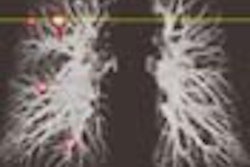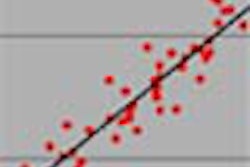Gadolinium is an acceptable alternative to iodinated contrast agents for discography in patients who have a history of prior severe allergic reactions to iodine, according to a small study reported last week at the American Academy of Pain Medicine meeting in New Orleans.
"Discography is frequently used to evaluate intervertebral disc pathology and is usually performed with iodinated contrast agents, allowing for excellent fluoroscopic visualization and post-discography CT evaluation," said Dr. Douglas Fenton, who is from the division of neuroradiology at the Mayo Clinic in Jacksonville, FL. "However, an alternative contrast agent is needed in patients who have a documented history of severe allergic reactions." Fenton’s co-authors are from the Mayo Clinic’s division of pain medicine.
Gadolinium has a significantly lower rate of severe allergic reactions than iodinated contrast agents, he said. In fact, severe allergic reactions to gadolinium reportedly occur in one of 400,000 patients, versus one in 500 patients with ionic iodinated media and one in 2,500 patients with nonionic iodinated contrast agents. Severe allergic reactions to iodine can result in anaphylactoid reactions and possible cardiovascular collapse if not treated immediately.
Fenton said that to his knowledge, the study is the first to look at the clinical efficacy of gadolinium with discography, both fluoroscopically and using CT, and to compare results to those seen with a noniodinated contrast agent.
All six patients were premedicated with steroids and H1 and H2 blockers as prophylaxis against contrast allergy. Lumbar discs were injected with either iohexol 300 mg/mL (Omnipaque, Amersham Health, Princeton, NJ) or gadolinium in 287 mg/mL (Omniscan, also from Amersham Health), such that both contrast agents were used in each patient at different disc levels.
The group performed subjective fluoroscopic visualization of the discs, and acquired radiographs of each disc for later assessment of the adequacy of contrast visualization.
All patients underwent post-discography CT evaluation. The CT images were evaluated for adequacy of contrast visualization and for relative density.
According to the results, the discs that had been injected with gadolinium were not as well visualized on fluoroscopy as the discs that had been injected with iodine, but the gadolinium contrast sufficiently demonstrated intranuclear filling and annular morphology, Fenton reported.
In addition, the CT scans demonstrated that the relative density of gadolinium was 43% of that obtained with iodinated contrast (787 HU versus 1,870 HU). Nonetheless, this density was more than adequate to demonstrate disc anatomy and annular tears. No patient developed an adverse reaction to the intradiscal gadolinium or noniodinated contrast.
Fenton concluded that gadolinium may be used in place of iodinated contrast agents in patients with a history of prior severe allergic reactions to iodine, but that high-quality fluoroscopy units should also be used in these patients. In select cases, it may be necessary to perform a CT scan after discography in order to demonstrate subtle intradiscal filling patterns and disc annulus morphology, he added.
Fenton emphasized the need for caution in the use of gadolinium in discography because toxicity studies have not been performed in this setting.
By Jill SteinAuntMinnie.com contributing writer
February 24, 2003
Related Reading
Acetylcysteine helps prevent nephrotoxicity during coronary angiography, February 6, 2003
MRI contrast: Addressing the issue of gadolinium and toxicity, November 26, 2002
Amersham gets FDA approval for Irish facility, July 11, 2002
Copyright © 2003 AuntMinnie.com




















